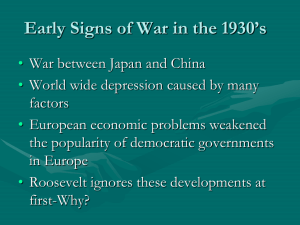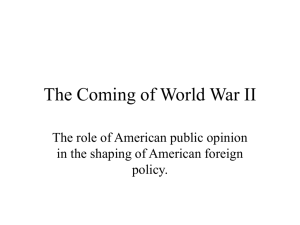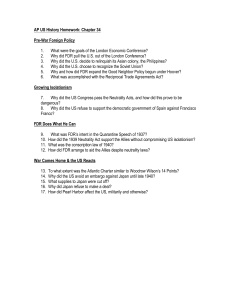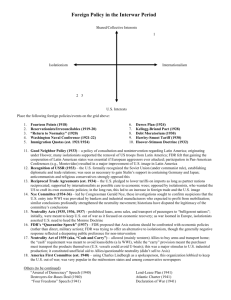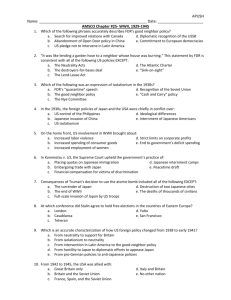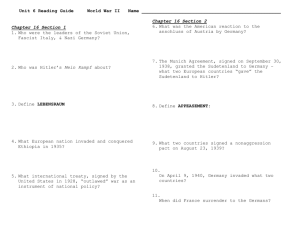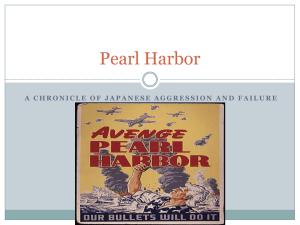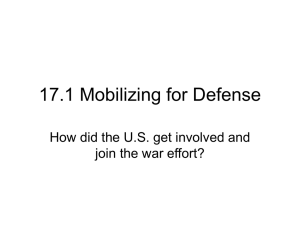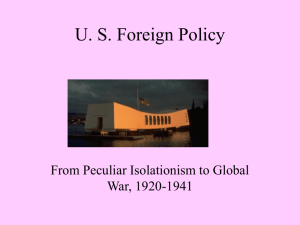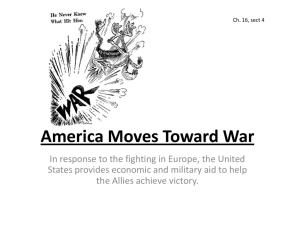The Coming of World War II
advertisement
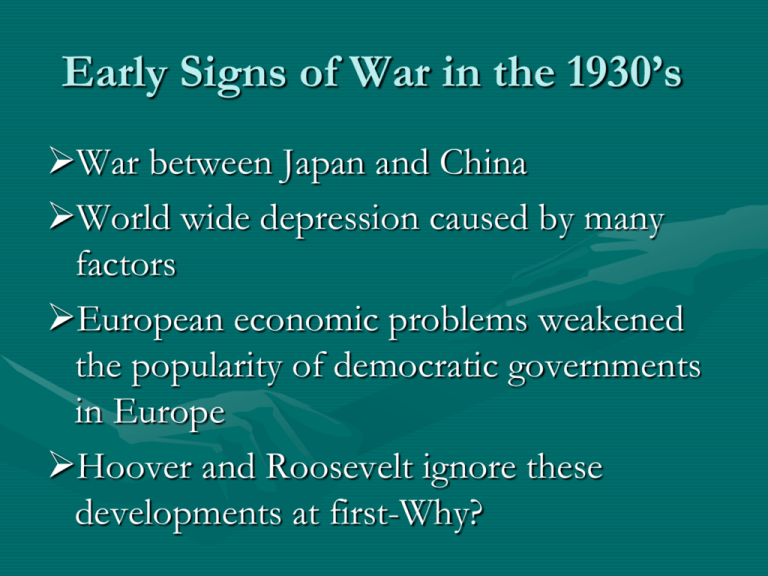
Early Signs of War in the 1930’s War between Japan and China World wide depression caused by many factors European economic problems weakened the popularity of democratic governments in Europe Hoover and Roosevelt ignore these developments at first-Why? Young Plan (1930) For three generations, you’ll have to slave away! $26,350,000,000 to be paid over a period of 58½ years. By 1931, Hoover declared a debt moratorium. Japanese Attack Manchuria (1931) League of Nations condemned the action. Japan leaves the League. Hoover wanted no part in an American military action in the Far East. Why not? Stimson Doctrine (1932) US would not recognize any territorial acquisitions that were achieved by force. Why would this infuriate the Japanese? Japan bombed Shanghai in 1932 massive casualties. FDR’s “Good Neighbor” Policy Important to have all nations in the Western Hemisphere united in lieu of foreign aggressions. FDR The good neighbor respects himself and the rights of others. Policy of non-intervention and cooperation. American Isolationism What were the Nye Committee hearings? What were their results? What were the 1935, 1936 and 1937 Neutrality Acts? Senator Gerald P. Nye [R-ND] The 1930’s: A Volatile World FDR Recognizes the Soviet Union (late 1933) FDR felt that recognizing Moscow might bolster the US against Japan. Maybe trade with the USSR would help the US economy during the Depression. The Early Aggression of Adolf Hitler Violation of the Treaty of Versailles— Rearmament Reoccupy and remilitarize the Rhineland (1936) Spanish Civil War (1936-1939) The American “Lincoln Brigade” US Neutrality Intensified American Isolationism (cont.) FDR’s “Quarantine Speech” (10/37) After Japan’s invasion of China Proposed that democracies should act together to “quarantine any aggressor” Ludlow amendment proposed (1938) Panay Incident (1937) December 12, 1937. Japan bombed USS Panay gunboat & three Standard Oil tankers on the Yangtze River. Japan was testing US resolve! Japan apologized, paid US an indemnity, and promised no further attacks. Most Americans were satisfied with the apology. Results Japanese interpreted US tone as a license for further aggression against US interests. Fascist Aggression 1935: Hitler denounced the Versailles Treaty & the League of Nations [re-arming!] Mussolini attacks Ethiopia. 1936: German troops sent into the Rhineland. Fascist forces sent to fight with Franco in Spain. 1938: Austrian Anschluss. Rome-Berlin-Tokyo Pact [AXIS] Munich Agreement APPEASEMENT! 1939: German troops march into the rest of Czechoslovakia. Hitler-Stalin Non-Aggression Pact. September 1, 1939: German troops march into Poland blitzkrieg WW II begins!!! World War II Begins… FDR’s response: “Cash and Carry” 9/21/1939 FDR persuades Congress to allow the US to aid European democracies in a limited way: The US could sell weapons to the European democracies on a “cash-and-carry” basis. FDR was authorized to proclaim danger zones which US ships and citizens could not enter. Results: Aggressors could not send ships to buy US munitions. The US economy improved as European demands for war goods helped bring the country out of the 1937-38 recession. America becomes the “Arsenal of Democracy.” U.S. Reaction to the start of WW II Isolationism at its peak in the late 1930’s Neutrality in action but not thought CDAAA organized (1940) Paris falls in June 1940 U.S. Reaction to WW II (cont.) “America First” movement (1940) “Destroyers for bases” deal (Sept., 1940) The Lend-Lease Act (March, 1941) Lend-Lease Aid to the Soviets (June, 1941) U.S. Reaction to Hitler’s Aggression American “neutrality patrols” The Atlantic Charter (Aug. 1941) Undeclared naval war with the Germans in the Atlantic ocean USS Greer (Sept. 1941) USS Reuben James (Oct. 1941) Japanese Aggression in the Far East • Make a list of the sources of tension between the US and Japan from the 1880’s to 1940? After Japan extended their control in China, the US placed restrictions on many imports, including oil Japan began to look around southeast Asia for resources The Road to Pearl Harbor Japan wanted to create the “Greater-East Asia Co-Prosperity Sphere.” That was code for a Japanese Empire. America contested that and hoped the Japanese would curtail their Pacific Expansion. Japan saw the Pacific Ocean as an “American Lake” and the American Navy as a threat to their ambitions. Invades Northern Indochina (Summer of 1940) Tripartite Pact (Sept., 1940) Invades southern Indochina (July, 1941) The Japanese knew that this would threaten US interests in the Pacific •Japanese militarists including Prime Minister General Hideki Tojo wanted war with America and figured we had no stomach for a protracted Asian war The task of dealing with the Americans fell to Admiral Isoroku Yamamoto. Yamamoto studied here in the United States (Naval War College and Harvard) and knew us well. Unlike other Japanese military, he respected us. Yamamoto planned the attack on Pearl Harbor. The idea was to crush the American Navy and then, hopefully, negotiate a settlement in place of a long, bloody war.—”Limited Goals” Yamamoto promised 6 months of success before American industrial might turned the tables Yamamoto also knew that NOTHING would make the Americans angrier. After the raid at Pearl Harbor, Yamamoto said: “I am afraid all we have done is awaken a sleeping giant and filled him with a terrible resolve.” The Japanese Attack on Pearl Harbor A “Surprise” Attack The significance of the aircraft carrier “Day of Infamy” “Tora, Tora, Tora!” The problem created by the attack for the Japanese Conspiracy theory?
